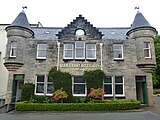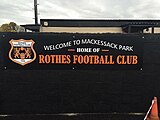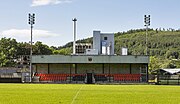Rothes
This article needs additional citations for verification. (December 2017) |
Rothes
| |
|---|---|
 High Street, Rothes | |
 Rothes Location within Moray | |
| Population | 1,252 (2011) |
| Demonym | Rothesian |
| OS grid reference | NJ278492 |
| Council area | |
| Lieutenancy area | |
| Country | Scotland |
| Sovereign state | United Kingdom |
| Post town | ABERLOUR |
| Postcode district | AB38 |
| Dialling code | 01340 |
| Police | Scotland |
| Fire | Scottish |
| Ambulance | Scottish |
| UK Parliament | |
| Scottish Parliament | |
Rothes (/ˈrɒθɪs/; Scottish Gaelic: Ràthais) is a town in Moray, Scotland, on the banks of the River Spey, 10 miles (16 km) south of Elgin. The town had a population of 1,252 at the 2011 Census. A settlement has been here since AD 600.

Entering Rothes from the south, with the castle in the background

Rothes Parish Kirk

Rothes High Street
History and castle[]
At the south end of the village lie the remains of Rothes Castle (57°31′31″N 3°12′33″W / 57.5252°N 3.2092°W), built on a hill by Peter de Pollok about 1200 to command traffic up and down this stretch of Strathspey. The castle's remains consist of a fragment of the massive outer wall overlooking the High Street of Rothes town. The castle was four storeys high, with a portcullis guarding the entrance to the inner courtyard and a drawbridge that crossed the dry moat, which ran between the outer wall and the hill on which the castle stood. Sir Norman Leslie, the castle's owner, was host to King Edward I of England on 29 July 1296, during his triumphal march through Scotland following its conquest by him in 1296. On the visit, Sir Norman pledged his allegiance to the king.
In the 1390s Rothes Castle and its lands were passed to the Leslie family, who would later become the Earls of Rothes.[1] Some of the earliest houses in Rothes were built from stones of the castle, which were taken by villagers to build dwellings after the castle was set alight and destroyed in 1662. The town can clearly be seen on maps even before this date.[2] The villagers had burnt the castle to its current state, since it had become a refuge for tramps and thieves after being abandoned. Rothes's earls sold their Moray estates to the Seafield family around 1700, and by this time Rothes had grown past the immediate area of the now long-ruined castle, into a village aligned east-west along the line of the burn running into the Spey. After selling up, the earls of Rothes moved to Fife, buying land which, much later, would become the site of the new town of Glenrothes.

Remains of Rothes Castle

Rothes Castle from the East
An official notice by James, Earl of Findlater, of intention to feu a town on the Mains of Rothes was placed on 12 December 1763 to the Elginshire Council, and in 1766 the Seafields laid out plans for a crofting township to align north-south along the valley. This forms the genesis of most of the road patterns in Rothes today. The planned town formed a cross to replicate the Saltire in honour of St. Andrew. It overlay its old unplanned predecessor, which can still be seen on the ground. A formal let of 23 tenements by the earl were placed on 1 March 1790.[3]
Rothes was inhabited long before the castle was built; as far back as AD 600; missionaries had visited the area and built a chapel on Chapel Hill.
Economy[]
Rothes is home to four distilleries—Speyburn-Glenlivet Distillery, Glen Grant Distillery,[4] Glen Spey Distillery and Glenrothes Distillery. Caperdonich distillery was the fifth in the town but was mothballed in 2002 and demolished in 2010.
Rothes's Glen Grant distillery opened its own bottling plant in 2013. The distillery forms part of the Scotland's Malt Whisky Trail.[5]
The Helius CoRDe Biomass Plant[6] was a joint venture by the Combination of Rothes Distillers Ltd and Helius Energy. It was officially opened by Charles, Duke of Rothesay, on 16 April 2013. It burns a combination of whisky distillery by-products and wood chips to create enough electricity to power up to 9,000 homes.

The Helius CoRDe Biomass Plant in Rothes

Glen Grant Distillery

Forsyths
In addition to the distilleries, Forsyths Ltd[7] is a major employer in the town. They specialize in fabrication for the oil and gas industry and the alcoholic-beverage industry. In the oil and gas sector they provide structural steelwork, piping, pressure vessels, umbilical/pipe reels and tanks. In the alcohol sector they provide distillation equipment for distilleries' construction, plant upgrades and expansion projects. They also provide equipment for both domestic and international beer, wine and spirit producers. Forsyths' portfolio includes Grants of Dufftown Ltd, Forblast, McCormacks, G&A Construction, Castelhill Services and Northern Fabricators.
Transport[]
Before 1968 Rothes had a railway station in the centre of town, which featured staggered platforms and unusual architecture.[8] On the Orton line, it opened to passenger traffic on 23 August 1858 and was served by the Morayshire Railway. An extension to the line, from Rothes to Craigellachie, was opened on 23 December 1858. A new line between Elgin and Rothes was opened to freight on 30 December 1861 and to passengers on 1 January 1862. The Orton line closed on 31 July 1866, and on 4 November 1968 the Elgin to Rothes line was closed to freight and passengers. Today, nothing remains of the station.

Rothes Railway Station looking south on 27 May 1968, the closure notice is being read.

A class 24 arrives at Rothes with a train for Aberdeen in May 1968

Rothes Railway Station with the Station name
Rothes lies on the A941 and is easily accessible by car. The town is also served by regular buses to and from Elgin, which also travels to Craigellachie, Aberlour and Dufftown.
Sport and leisure[]
Rothes F.C.[9] are the town's senior football team, playing their games at Mackessack Park in the Highland Football League. Rothes Amateurs are the town's other football team and play in the Moray District Welfare League on the town's park. Rothes also has a bowling club, a tennis club and a golf club. One can fish on the River Spey or go to the Glen of Rothes Trout and Coarse Fishery just outside the town.

Mackessack Park Entrance

Rothes FCs' Main stand at Mackessack Park
Other facilities[]
Rothes Police Station is the only station in the area that is manned 24 hours a day; it covers the whole of Speyside. All the other stations in the valley were closed due to cut-backs. Rothes is also manned by a retained fire station and a GP's surgery.
Rothes Visitor Centre, locally known as The Cottage, has been open since 1995, provides a range of useful services. Tourist information leaflets are available and the volunteers have much knowledge about the surrounding area.
Rothes Primary School,[10] which opened in 1916, educates the town's children from primary 1 to 7, at which point they further their education at Speyside High School, located 5 miles south in Aberlour.

Rothes Primary School
Before Speyside High School was opened in August 1976, Rothes Primary School was also a junior secondary school, taking pupils up to third year. From third to sixth year the pupils had to go to Elgin Academy. In 1966 it was reduced to a two-year secondary and from August 1969 all secondary education was carried out at Elgin Academy. Until Speyside High School was fully established as a secondary education facility, the Rothes Primary 7 pupils had the option of attending either Elgin (if a sibling attended) or the new Speyside complex.
Rothes Flood Alleviation Scheme[]
Rothes has a very long history of flooding. On numerous occasions, houses have been flooded from a combination of the Back Burn, the Burn of Rothes and the Black Burn.
The £25 million Rothes Flood Alleviation Scheme was devised to alleviate flooding from these burns. The works were completed in May 2011, £2.4 million under budget.[11]
The works were
- Channel-widening
- Replacement of existing bridges
- Reinforced concrete flood walls and mini-piled foundations
- Earthwork embankments
- Bank protection works to prevent future scour
The works were programmed to suit various environmental constraints, including salmon spawning.
The scheme provides a standard of flood protection of at least 1 in 100 years plus an allowance for climate change.
Climate[]
Rothes has an oceanic climate typical of Northern Scotland, characterised by relatively mild, damp winters and cool cloudy summers. The area averages 76 air frosts a year. Like much of Europe, Rothes' climate is insulated somewhat by the Gulf Stream, a warm ocean current originating near the gulf of Mexico. This warm ocean current makes Rothes's climate significantly milder during the winter than expected for its latitude.
| hideClimate data for Keith (Nearest climate station to Rothes) 1981–2010 | |||||||||||||
|---|---|---|---|---|---|---|---|---|---|---|---|---|---|
| Month | Jan | Feb | Mar | Apr | May | Jun | Jul | Aug | Sep | Oct | Nov | Dec | Year |
| Average high °C (°F) | 5.9 (42.6) |
6.4 (43.5) |
8.4 (47.1) |
11.0 (51.8) |
13.8 (56.8) |
16.0 (60.8) |
18.5 (65.3) |
18.1 (64.6) |
15.6 (60.1) |
12.0 (53.6) |
8.3 (46.9) |
5.7 (42.3) |
11.6 (53.0) |
| Average low °C (°F) | −0.6 (30.9) |
−0.6 (30.9) |
0.8 (33.4) |
2.6 (36.7) |
4.9 (40.8) |
7.8 (46.0) |
9.8 (49.6) |
9.4 (48.9) |
7.2 (45.0) |
4.5 (40.1) |
1.8 (35.2) |
−1.0 (30.2) |
3.9 (39.0) |
| Average precipitation mm (inches) | 65.7 (2.59) |
57.8 (2.28) |
63.2 (2.49) |
59.6 (2.35) |
60.8 (2.39) |
77.8 (3.06) |
70.6 (2.78) |
75.6 (2.98) |
89.2 (3.51) |
100.9 (3.97) |
91.9 (3.62) |
64.7 (2.55) |
877.8 (34.57) |
| Mean monthly sunshine hours | 45.9 | 77.3 | 108.2 | 142.2 | 190.0 | 152.7 | 156.8 | 145.6 | 117.5 | 89.6 | 53.2 | 35.0 | 1,314 |
| Source: Met Office | |||||||||||||
Notable people[]
- Admiral Sir Martin Eric Dunbar-NasmithVC, KCB, KCMG, born on 1 April 1883 was a Royal Navy officer and a recipient of the Victoria Cross, the highest award for gallantry in the face of the enemy that can be awarded to British and Commonwealth forces. Before retiring in 1946 Nasmith moved to Rothes living out the remainder of his days in the town. He died in 1965, aged 83, and is buried at Elgin cemetery. The Dunbar-Nasmith family have had a long association with Rothes, with the family home being Auchinroath, just outside the town. On 25 June 2015 the Royal Navy hosted a ceremony for the unveiling of a commemorative Victoria Cross paving stone at the towns war memorial hosted by Lieutenant Colonel Grenville Johnston, Lord Lieutenant of Moray, assisted by Rothes Parish Reverend Bob Anderson to celebrate the Admiral's efforts 100 years on. Rothes residents and primary school pupil's gathered to pay tribute. Wreaths were laid by the Lord Lieutenant, Royal Navy, Moray Council, Submariners Association, Royal Naval Association Sea Cadets and Rothes Primary School.
- James ‘The Major’ Grant, born in 1847, inherited Glen Grant Distillery in 1872 when the founders died. Stories about ‘The Major’ abound. A legendary innovator, socialiser and traveller, he lived by his own rules and set his own standards. New ideas fascinated him and he wasn’t afraid to explore them. He was the first person in the region to own a motor vehicle. His was the first distillery to have electric lighting, and his favourite party trick was to take house guests to a stream at the top of his vast Victorian woodland garden and produce a bottle of whisky from a safe concealed behind a waterfall. In 1896 he sailed to India to hunt tigers, and was photographed on one expedition riding proudly on an elephant. A few years later he travelled to southern Africa to hunt big game. When the hunting party returned to Bulawayo he was accompanied by a young companion. The Europeans had found two small boys abandoned as they passed through famine-ravaged countryside, and feared for their safety. The Major decided to take one of them back to live with him in Rothes. Biawa Makalaga became the Major’s page boy and later his butler. Biawa continued to live in a flat at Glen Grant House long after the Major died in 1931, until his own death in 1972.
- Lucy Noël Martha (Noël or Noëlle), Countess of Rothes, Lady Rothes, born on 25 December 1878 was the wife of the 19th Earl of Rothes. A noted philanthropist and social leader, she was a heroine of the Titanic disaster, famous for taking the tiller of her lifeboat and later helping row the craft to the safety of the rescue ship Carpathia.[12]
References[]
- ^ "Rothes Castle and The Earl". Retrieved 2 November 2015.
- ^ "Robert and James Gordon Map". Retrieved 2 November 2015.
- ^ "Rothes' Beginnings". Retrieved 1 October 2015.
- ^ "Glen Grant Distillery". Retrieved 4 May 2014.
- ^ "Scotland's Malt Whisky Trail". Retrieved 4 May 2014.
- ^ "The Helius CoRDe Biomass Plant". Retrieved 2 October 2015.
- ^ "Forsyths". Retrieved 1 October 2015.
- ^ "Rothes Railway Station". Retrieved 10 October 2015.
- ^ "Rothes F.C." Retrieved 4 May 2014.
- ^ "Rothes Primary School". Retrieved 2 October 2015.
- ^ "Rothes Flood Alleviation Scheme". Retrieved 2 October 2015.
- ^ New York Times, 20 April 1912.
External links[]
- Rothes
- Towns in Moray















